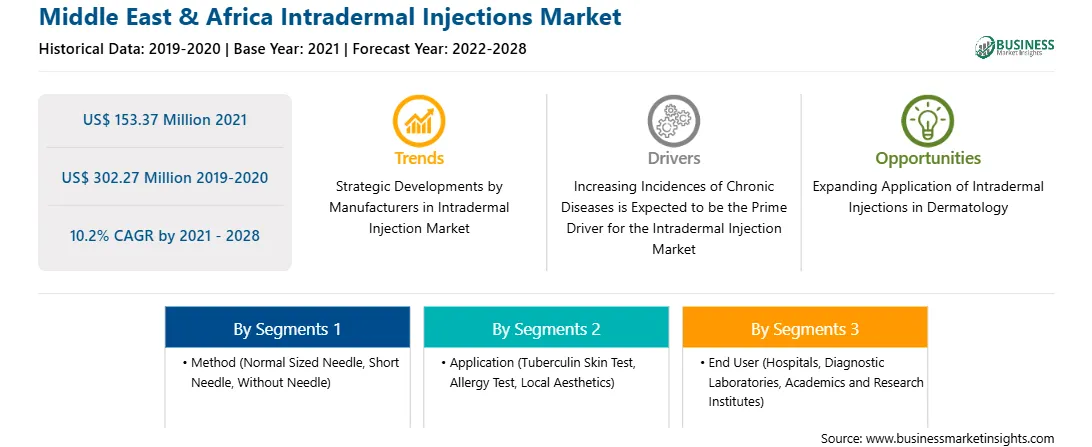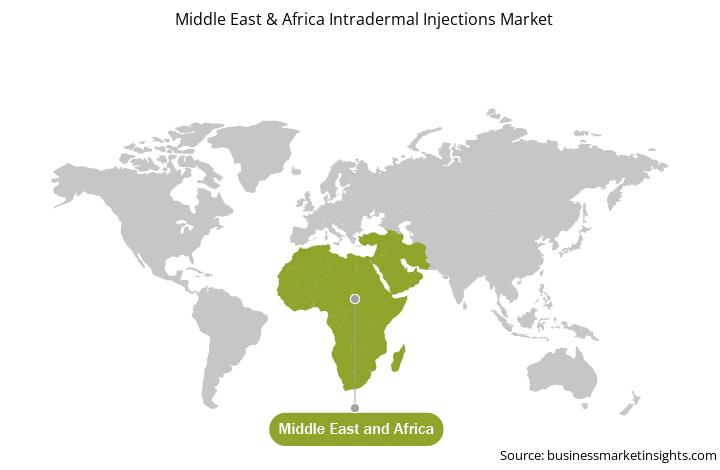The rising acceptance of intradermal vaccination is believed to act as a major driver for the Middle East & Africa intradermal injection market as it has several advantages over the conventional method of vaccination. Intradermal vaccination helps in reducing the potential dose of antigens, improves the immune response generated by vaccines, and decreases the anxiety associated with the vaccination. By developing intradermal injections, a large population can be vaccinated with comparatively lesser volumes of vaccines. The method would also help authorities in vaccinating the difficult group of population with comorbidities, as the chances of adverse events are lower than that in conventional vaccination. Intradermal vaccines against COVID-19, hepatitis A, hepatitis B, influenza, polio, measles, rabies, tetanus, yellow fever, diphtheria-tetanus-pertussis, etc., show improvement in the overall response rate, and hence, several leading pharmaceutical and biotechnological companies are currently working on the development of intradermal injections of the new as well as already commercialized vaccines. Pfizer got approval for intradermal COVID-19 vaccines—Comirnaty—for vaccinating people of age more than 16. Therefore, the increasing preference for intradermal vaccination boosts the growth of the market in the Middle East & Africa.
The intradermal injections market in the Middle East & Africa is segmented into Saudi Arabia, South Africa, the UAE, and rest of Middle East & Africa. The market in this region is anticipated to grow at a CAGR 19.6% during the forecast period; this growth is attributed to the rising prevalence of various diseases and increasing funding and healthcare-related policies from governments. Saudi Arabia has a national healthcare system, wherein the government offers free medical services through different government-aided medical facilities. The private sector also plays an increasingly important role in the delivery of health care services. Saudi Arabia dominates the pharmaceutical market of the Middle East, which can be ascribed to a vast population base, and the elevating prevalence of several communicable and noncommunicable diseases. The government of Saudi Arabia is promoting and offering several incentives for the domestic manufacturing of medical devices, which, in turn, can drive the overall market growth in this country. Thus, well-developed research centers and focus on increasing research studies for the treatment of various respiratory diseases are expected to fuel the growth of the intradermal injections market in the Middle East & Africa in the coming years. The dependence of Saudi Arabia on export has reduced remarkably in the past few years, primarily due to the increasing involvement of regional players in the market. The factors such as increasing cases of tuberculosis and allergies, rising spending on healthcare, and surging number of immigrants are expected to contribute to the market in this region in the coming years.

Strategic insights for the Middle East & Africa Intradermal Injections provides data-driven analysis of the industry landscape, including current trends, key players, and regional nuances. These insights offer actionable recommendations, enabling readers to differentiate themselves from competitors by identifying untapped segments or developing unique value propositions. Leveraging data analytics, these insights help industry players anticipate the market shifts, whether investors, manufacturers, or other stakeholders. A future-oriented perspective is essential, helping stakeholders anticipate market shifts and position themselves for long-term success in this dynamic region. Ultimately, effective strategic insights empower readers to make informed decisions that drive profitability and achieve their business objectives within the market.

| Report Attribute | Details |
|---|---|
| Market size in 2021 | US$ 153.37 Million |
| Market Size by 2028 | US$ 302.27 Million |
| Global CAGR (2021 - 2028) | 10.2% |
| Historical Data | 2019-2020 |
| Forecast period | 2022-2028 |
| Segments Covered |
By Method
|
| Regions and Countries Covered | Middle East and Africa
|
| Market leaders and key company profiles |
The geographic scope of the Middle East & Africa Intradermal Injections refers to the specific areas in which a business operates and competes. Understanding local distinctions, such as diverse consumer preferences (e.g., demand for specific plug types or battery backup durations), varying economic conditions, and regulatory environments, is crucial for tailoring strategies to specific markets. Businesses can expand their reach by identifying underserved areas or adapting their offerings to meet local demands. A clear market focus allows for more effective resource allocation, targeted marketing campaigns, and better positioning against local competitors, ultimately driving growth in those targeted areas.

The Middle East & Africa intradermal injections market is segmented on the basis of method, application, end user, and country.
Based on method, the market is segmented into normal sized needle, short needle, and without needle. The normal sized needles segment registered the largest market share in 2021. The normal sized needles segment is further sub segmented into intradermal microinjections, microneedle arrays, and tattoo devices. The short needle segment is bifurcated into intradermal liquid jet injectors and ballistic intradermal injectors.
In terms of application, the Middle East & Africa intradermal injections market is segmented into tuberculin skin test, allergy test, local aesthetics, and others. The tuberculin skin test segment held the largest market share in 2021.
The Middle East & Africa intradermal injections market, by end user, is segmented into hospitals, diagnostic laboratories, academics and research institutes, and others. The hospitals segment held the largest market share in 2021.
Based on country, the market is segmented into Saudi Arabia, South Africa, the UAE, and rest of Middle East & Africa. Saudi Arabia dominated the market share in 2021.
BD; West Pharmaceutical Services, Inc; Terumo Corporation; Nanopass; PharmaJet; Idevax; EUNSUNG GLOBAL; Crossject; Cardinal Health Inc; and Hindustan Syringes and Medical Devices Ltd are the leading companies operating in intradermal injections market in the Middle East & Africa region.
The Middle East & Africa Intradermal Injections Market is valued at US$ 153.37 Million in 2021, it is projected to reach US$ 302.27 Million by 2028.
As per our report Middle East & Africa Intradermal Injections Market, the market size is valued at US$ 153.37 Million in 2021, projecting it to reach US$ 302.27 Million by 2028. This translates to a CAGR of approximately 10.2% during the forecast period.
The Middle East & Africa Intradermal Injections Market report typically cover these key segments-
The historic period, base year, and forecast period can vary slightly depending on the specific market research report. However, for the Middle East & Africa Intradermal Injections Market report:
The Middle East & Africa Intradermal Injections Market is populated by several key players, each contributing to its growth and innovation. Some of the major players include:
The Middle East & Africa Intradermal Injections Market report is valuable for diverse stakeholders, including:
Essentially, anyone involved in or considering involvement in the Middle East & Africa Intradermal Injections Market value chain can benefit from the information contained in a comprehensive market report.